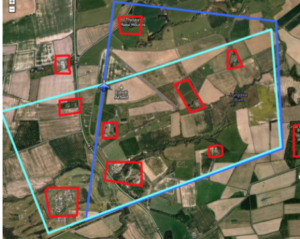The Charity
Aviation
Maritime
GA1327b

Initial Report
My point is in regard to the increasing number of avoid areas being included at airfields, with the term mandatory being used incorrectly. Mandatory is a legal term and means required by law, whereas this may be compulsory by the airfield operators and result in ppr refusal, it is not required by law. The term noise abatement is also being used. I am not wishing to be critical of the Airfield Operators who have an impossible task matching the needs of the based and visiting aircraft pilots and the local public who can be very demanding over aircraft flying over their houses. In some cases (see graphic) the number of noise sensitive areas are such that for a visiting pilot their attention is drawn to identifying and avoiding these areas rather than executing a standard join and circuit pattern. As we are well aware, distraction in the air can be very dangerous. It is also concerning that because pilots have the discretion to ignore these requirements if they feel that they conflict with safety, then a real danger of different landing patterns may occur.
I do not feel that these Avoidance / Noise Abatement Areas are necessary in all circumstances if a proper approach is undertaken on low power and therefore low noise, perhaps with an occasional small increase to hold height. A departure is at full power and therefore much noisier but most of the restrictions required appear to be related to the approach and circuit rather than the departure, which seems rather contradictory. I feel that we should not compromise safety simply to satisfy the public’s dislike of aircraft overflying their houses. I also feel that individual properties which are almost impossible to identify from the air should not be included, the number of areas kept as low as possible, and the circuits made to fit the overhead join pattern where an overhead join is the standard joining procedure. I also feel that the number of different procedures for small airfields, some with an AFIS and some with nothing, is too complicated and a degree of standardisation is required.
CHIRP Comment
In respect of the proliferation of avoids in Visual Circuit Patterns, I’m sure that we would all wish to see them reduced to the minimum but there will always be some sensitive areas near airfields and, although it is not feasible to avoid every house, all that can be done is to try to design circuit patterns that will cause the minimum nuisance. In that respect, we have to be tolerant of those who live near airfields because they can suffer from continuous noise from active circuit patterns that can sometimes become unbearable to them for whatever reason – airfields have to work with their local communities rather than ignore them. But when airfield operators are designing circuit patterns with this in mind, it’s important that the resultant patterns are both flyable and easy to navigate around so that pilots aren’t continuously having to transfer their attention away from flying the aircraft. Whilst a ‘standard’ template might be applied to ensure the visual circuit is recognisable in shape and form, aircraft have greatly differing performances and so one aircraft’s ‘sensible’ pattern might not be another’s. But we agree that significant deviations and ‘downwind navexs’ can soon negate the facility for expeditiously practising landings and take-offs once established in the visual circuit, and can also compromise overhead joins, so there needs to be a pragmatic solution to avoids. Some airfields spread the noise by alternating circuit directions at different times if the airspace allows but this can also cause confusion in itself if pilots forget or don’t know the ‘circuit pattern of the day’. The bottom-line is that when visiting unfamiliar airfields then any constraints on circuit patterns must be thoroughly reviewed as part of the flight planning process so that you’re fully aware of where you are going to fly once established in the visual circuit. In this respect, many electronic planning and navigation aids such as SkyDemon have the facility to display airfield circuit patterns and avoids as an overlay so this can be a very useful tool for pre-flight planning (as are internet satellite/aerial pictures) but beware of becoming distracted by focusing on electronic screens in flight to the detriment of lookout and the task of flying itself. There’s a lot of pre-flight preparation to be done before heading to an airfield you haven’t been to before, and note also that the rules of the air (SERA.3225(b)) require you to ‘conform with or avoid the pattern of traffic formed by other aircraft in operation’, not just conform to the published circuit pattern, and so you must also fit in with the other aircraft and their ground track in the circuit. The final point to make is that if you have an emergency or safety issue with your aircraft then the first priority is to fly the aircraft, avoiding noise-sensitive areas becomes secondary to that if you have control limitations or urgently need to land.
Key Issues relating to this report
Dirty Dozen Human Factors
The following ‘Dirty Dozen’ Human Factors elements were a key part of the CHIRP discussions about this report and are intended to provide food for thought when considering aspects that might be pertinent in similar circumstances.
Pressure – anxiety to conform to published procedures
Distraction – capacity being reduced due to the need to avoid sensitive areas
Knowledge – the need to be clear about circuit procedures as part of pre-flight planning
Deviation – non-standard circuit patterns causing confusion or errors
This data type is not supported! Please contact the author for help.